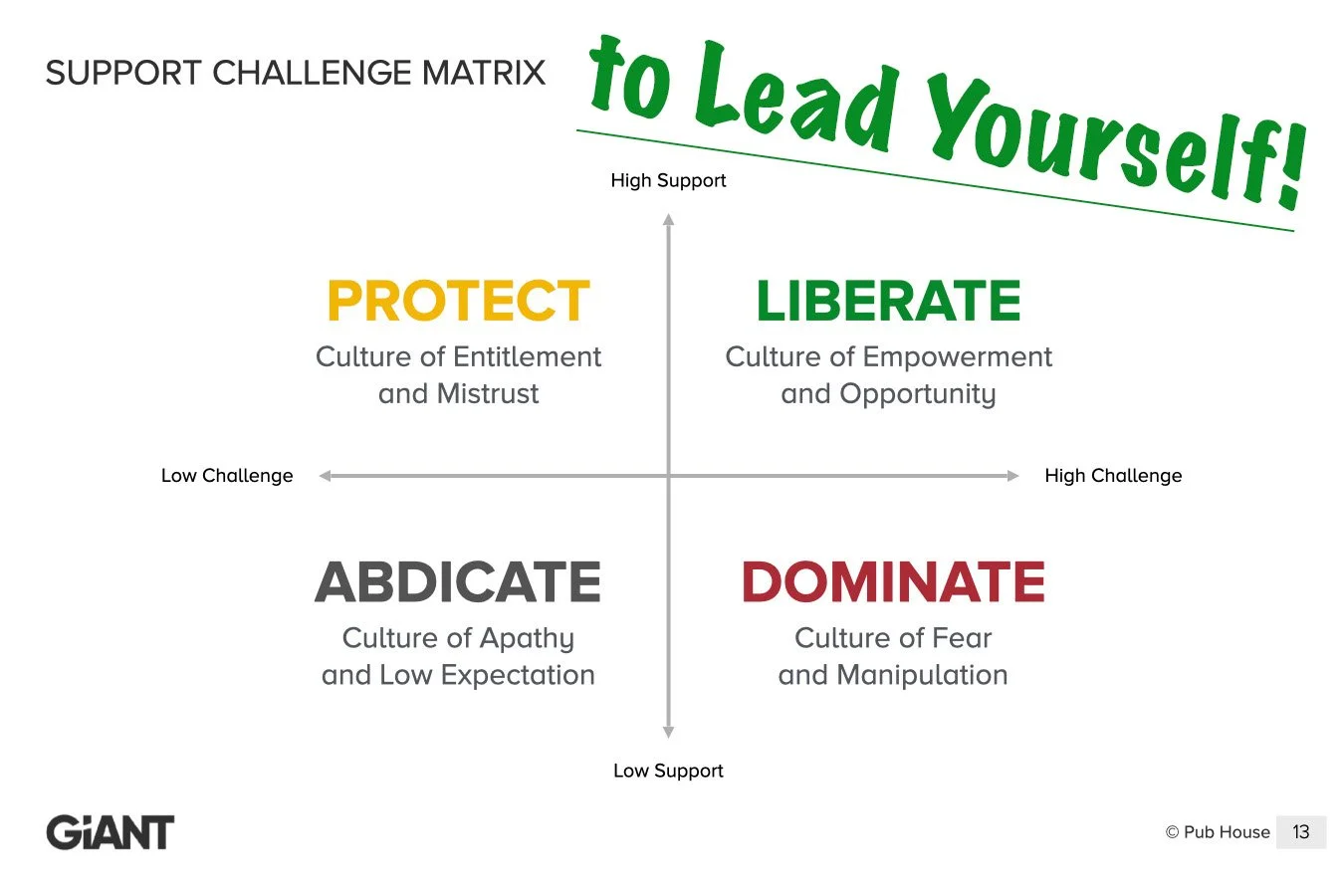The Secret to Leading Yourself Well
Welcome to another Toolkit Tuesday! This week, we’re taking a more personal approach to the Support Challenge Matrix—not how you use it to lead others but how you can use it to lead yourself.
The Challenge
As leaders, we often focus on supporting and challenging others, but what about ourselves?
Have you ever found yourself stuck in patterns like these?
You push yourself too hard without taking the time to rest or reflect, leaving you burned out and overwhelmed.
You give yourself a lot of grace but fail to challenge yourself to grow, causing you to feel stagnant or frustrated.
Let me (Matt) share a personal story.
There was a time in my life when I’d wake up in the morning, go into the bathroom, look in the mirror, and hear a narrative I told myself about my worth and identity. I vividly remember one season when I was simply taking each day as it came—reacting to situations as they arose, but not intentionally shaping my future or bettering myself.
I was stuck in the Abdicate zone—avoiding responsibility, growth, and self-leadership. Over time, this began to affect my work, my family and my relationships. I wasn’t showing up as the leader I wanted to be in any area of my life.
It wasn’t until I learned how to properly calibrate support and challenge for myself that things began to change. By fighting for my highest possible good, I began to take ownership of my growth, my goals, and ultimately, my life.
The Tool: Support Challenge Matrix
The Support Challenge Matrix isn’t just for your team—it’s also a tool to evaluate and improve how you lead yourself. Here’s what the quadrants look like when applied to self-leadership:
Low Support, Low Challenge (Abdicate): You avoid responsibility and growth, leading to apathy, low motivation, and a sense of aimlessness.
High Support, Low Challenge (Over-Comfort): You prioritize rest, grace, or self-care but avoid pushing yourself, leading to stagnation.
High Challenge, Low Support (Self-Criticism): You set high expectations but fail to extend yourself grace, creating burnout, frustration, and negative self-talk.
High Support, High Challenge (Self-Liberation): You give yourself the encouragement, tools, and grace needed to grow while also holding yourself accountable to your goals. This is where personal growth thrives.
Why This Matters
As a leader, you cannot give what you don’t possess.
If you lack self-support, it’s challenging to authentically support others.
If you fail to challenge yourself, it’s hard to model the growth and accountability you expect from your team.
Leading yourself well ensures that you’re operating from a place of health, strength and balance. This makes you more effective in every area of your life—personally and professionally.
When you take time to reflect on your own needs for support and challenge, you set an example of what it means to grow with intention. You also build the capacity to lead others from a place of overflow, rather than burnout or stagnation.
The Result
When you lead yourself in the high support, high challenge zone, you’ll experience:
Greater resilience to navigate challenges and setbacks.
Consistent personal growth that fuels your leadership.
A deeper sense of fulfillment as you achieve goals while staying healthy and balanced.
Action Step
This week, reflect on how you’re leading yourself and take these steps:
Assess Your Current Zone: Are you in a pattern of low support and low challenge, over-comfort, or self-criticism?
Increase Support: What would it look like to give yourself more encouragement, grace, or resources to grow? Examples: Scheduling regular time for reflection, seeking out a mentor or accountability partner, or celebrating small wins.
Raise Challenge: Where could you hold yourself more accountable to your goals or push outside your comfort zone? Examples: Setting a specific, measurable goal, tackling a challenging project, or committing to a personal growth plan.
Calibrate Both: Aim to keep both support and challenge high to create the conditions for sustainable growth and resilience.
By using the Support Challenge Matrix to lead yourself, you’ll not only grow personally but also create a ripple effect in how you lead and inspire others.
What’s one small adjustment you can make this week to bring yourself closer to the high support, high challenge zone?

